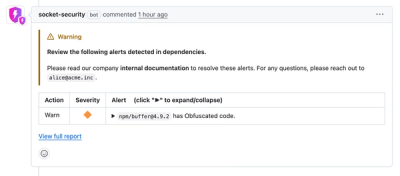
Security News
Crates.io Users Targeted by Phishing Emails
The Rust Security Response WG is warning of phishing emails from rustfoundation.dev targeting crates.io users.
client-side-renderer
Advanced tools
Client side renderer is a npm package to help you render HTML pages better and easier and was made to supplement Electron but can also be used on the front end
Client side renderer can be used to help or fully render your electron application
You can install this package into your project using npm
npm install client-side-renderer
to get started create a new javascript file and start with this boilerplate code;
const {RendererConfig , render} = require('client-side-renderer')
// creates a object to repersent the page
const page = new RendererConfig();
// creates a property using the type and id props to be appended to the body
page.createElementOnBody("div" , "top");
// adds a element to the div property with the id of top
page.createChildOf("div-top" , "h1" , "main-header" , "Hello World");
// appends to the h1 stored in index 0 of the child array
page.createChildOf(0 , "h3" , "" , "from client-side-renderer");
Elements that have the same tag name and are to be appended onto the body must have a unique id.
children of elements that are appended on the body do not need ids because they are referanced by their index in the children array
you can look at the items in the children array by logging page.children to the console
only the function createChildOf adds to the children array by counting the amount of times this function is called and subtracting 1 you can get the array index for referance
Newest Features in v1.1.0
The element editor is a class and uses a selector (same as if you were using querySelector or querySelectAll) and can grab one or more elements and make changes to them. With the element editor you can edit the innerHTML Classlist and values.
const {ElementEditor} = require("client-side-renderer")
// true refers if there are mutiply elements you want to select the default is false
const inputGroup = new ElementEditor(true);
// set the selector if you were using query selector you can also set it when you create the object
inputGroup.selector = "form#add input.formInput"
// grabs the elements for you and saves them in the object
inputGroup.getElements();
// edits all elements. the first argument tells what you are value you are changing
// and the second is what the new value to be added is
inputGroup.editAll("innerHTML" , "Hello World");
// edits one element out of the group only works on multiple elements
// you must give it vaild id
inpuGroup.editOne("uniqueId" , "innerHTML" , "from client-side-renderer")
The new pageLoader object allows you to save your pages for referance and access them when the page needs to change.
const {RendererConfig , pageLoader} require("./client-side-renderer");
const page = new RendererConfig();
// create page to render
page.createElementOnBody("h1" , "header" , "Hello world" );
page.createElementOnBody("h3" , "" , "from client-side-renderer");
// instead of renderering the page use pageloader's save method
// homePage is the name of the page and what you uses to retrive the page with the load method
pageLoader.save("homePage" , page);
// when the you want the page to load call the load method on pageloader with the name of the page you gave
pageLoader.load("homePage")
when attaching a child to a element on the body instead of writing [element , id] you can now write element-id where element is the name of the element and id is the id you gave it. The two values are seperated by a hypen.
if there is no id or id is an empty string just use the element name. element
page.createElementOnBody("div" , "top");
page.createChildOf(["div" , "top"] , "h1" , "" , "Old way");
page.createElementOnbody("div" , "top");
page.createChidlOf("div-top" , "h1" , "" , "new way")
bug fixes
FAQs
A simple html renderer for electron or the front end
We found that client-side-renderer demonstrated a not healthy version release cadence and project activity because the last version was released a year ago. It has 1 open source maintainer collaborating on the project.
Did you know?

Socket for GitHub automatically highlights issues in each pull request and monitors the health of all your open source dependencies. Discover the contents of your packages and block harmful activity before you install or update your dependencies.

Security News
The Rust Security Response WG is warning of phishing emails from rustfoundation.dev targeting crates.io users.

Product
Socket now lets you customize pull request alert headers, helping security teams share clear guidance right in PRs to speed reviews and reduce back-and-forth.

Product
Socket's Rust support is moving to Beta: all users can scan Cargo projects and generate SBOMs, including Cargo.toml-only crates, with Rust-aware supply chain checks.